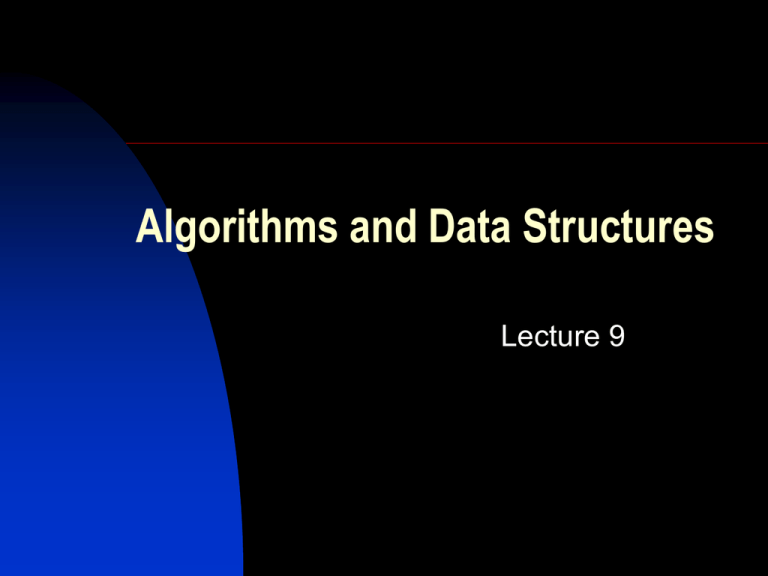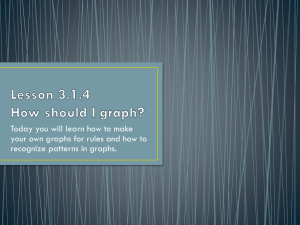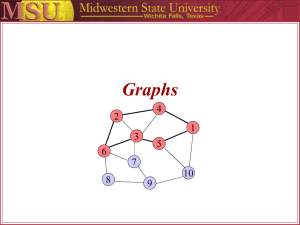lect9
advertisement

Algorithms and Data Structures
Lecture 9
Agenda:
Graph traverse
Breadth-first search algorithm
Depth-first search algorithm
Topological sort
Graphs: traverse
Sometimes we need to perform some
procedure on all vertices of a graph
Task can be accomplished visiting each
vertex of a graph (from vertex from
vertex) and performing required
procedure
Such task is known as graph traverse
Let’s examine two well-known graph
traverse algorithms: breadth-first search
and depth-first search algorithms
Graphs: traverse
The ideas behind graph traverse
algorithms are the following:
For given graph G and some vertex s,
algorithm builds paths from vertex s to all
vertices, attainable from s
Paths built from a given vertex constitute
a tree
Some vertices of a graph (unattainable
from vertex s) may remain out of a tree;
procedure is repeated until all the
vertices of a graph will be covered by
some tree
Trees (of a given graph) constitute a
forest
Graphs: traverse
Graphs: traverse
Graphs: traverse
Graphs:
breadth-first search
Breadth-first search is one of graph
traverse algorithms
Algorithm is often used by other
algorithms
Algorithm is applicable for both
directed and undirected graphs
Graphs:
breadth-first search
Input: graph G
Output: breadth-first forest
Any vertex of a G may be colored in
white, gray or black color
White vertices are unvisited, gray –
discovered vertices, black – already
processed vertices (finished)
Q – auxiliary storage (queue) of FIFO
type; holds discovered vertices (gray)
Initially, G consists of white vertices only;
finally, all the vertices of a G are black
Graphs:
breadth-first search
Step 1: all the vertices are marked as
white
Step 2: start with any white vertex s; it is
marked as gray and added to the Q
Step 3: get first vertex x from the Q
Step 4: each adjacent to x white vertex is
added to the Q and marked as gray
Step 5: vertex x is removed from the Q,
marked as black and “some” vertex
processing procedure is performed (e.g.
printing)
Step 6: if Q is non-empty go to step 3
Step 7: continue from step 2 until G has
no more white vertices
Graphs: breadth-first
search, sample
Graphs: breadth-first
search, sample
Graphs: breadth-first
search, sample
Graphs: breadth-first
search, sample
Graphs: breadth-first
search, sample
Graphs: breadth-first
search, sample
Graphs: breadth-first
search, sample on usage
Graphs: breadth-first
search, sample on usage
Graphs: breadth-first
search, sample on usage
Graphs: breadth-first
search, sample on usage
Graphs:
breadth-first search
For given graph G and some white
vertex s, algorithm builds paths from
vertex s to all vertices, attainable from s
Paths are shortest
Paths built from a given vertex constitute
a breadth-first tree
Breadth-first trees (constructed while
considering distinct white vertices)
constitute a breadth-first forest
Changing order of considered white
vertices may produce another breadthfirst forest
Graphs:
breadth-first search
Graphs:
breadth-first search
Graphs:
depth-first search
Depth-first search is one of graph
traverse algorithms
Algorithm is often used by other
algorithms
Algorithm is applicable for both
directed and undirected graphs
Graphs:
depth-first search
Input: graph G
Output: depth-first forest
Any vertex of a G may be colored in
white, gray or black color
White vertices are unvisited, gray –
discovered vertices, black – already
processed vertices (finished)
Initially, G consists of white vertices only;
finally, all the vertices of G are black
Graphs:
depth-first search
Step 1: all the vertices are marked as
white
Step 2: start with any white vertex s
Step 3: vertex s is marked as gray
Step 4: for each adjacent to s white
vertex algorithm performs recursive
reentrance (steps 3-5)
Step 5: if there are no more adjacent to s
white vertices in G, algorithm marks
vertex s as black and performs some
procedure under the vertex (e.g. prints
data)
Step 7: continue from step 2 until G has
no more white vertices
Graphs:
depth-first search, sample
Graphs:
depth-first search, sample
Graphs: depth-first search,
sample on usage
Graphs: depth-first search,
sample on usage
Graphs: depth-first search,
sample on usage
Graphs:
depth-first search
For given graph G and some white
vertex s, algorithm builds paths from
vertex s to all vertices, attainable from s
Paths built from a given vertex constitute
a depth-first tree
Breadth-first trees (constructed while
considering distinct white vertices)
constitute a depth-first forest
Changing order of considered white
vertices may produce another depth-first
forest
Graphs:
depth-first search
Graphs:
depth-first search
Graphs: topological sort
Let G=<V,E> is a directed acyclic graph
Let’s define comparison operation on V
Vertices u and v are comparable and u<v
if exists directed edge (u,v)
Vertices u and w are comparable and
u<w if exist some vertex v and edges
(u,v) and (v,w); u<v & v<w => u<w
Otherwise two vertices are incomparable
Graph may not have cycles as relation
u<u is invalid
Graphs: topological sort
The task of topological sort
assumes rearrangement of all
graph vertices to a linear sequence
Input: set of vertices V={v1,v2,…,vn}
Output: sequence of vertices
S=(v1,v2,…,vn), where vi<vk while
i<k, or vi and vk are incomparable
at all
Graphs: topological sort
Graphs: topological sort
Graphs: topological sort
Algorithm:
Step 1: Allocate storage S for
sorted vertices, |S|=|V|
Step 2: Perform Depth-First
Search under the graph G; each
finished (black) vertex is added to
the end of the sequence S
Step 3: Sequence S is
topologically sorted set of vertices
Graphs: topological
sort, sample
Graphs: topological
sort, sample
Graphs: topological
sort, sample
Graphs: topological
sort, sample
Graphs: topological
sort, sample
Graphs: topological
sort, sample
Graphs: topological
sort, sample on usage
Graphs: topological
sort, sample on usage
Graphs: topological
sort, sample on usage
Q&A









